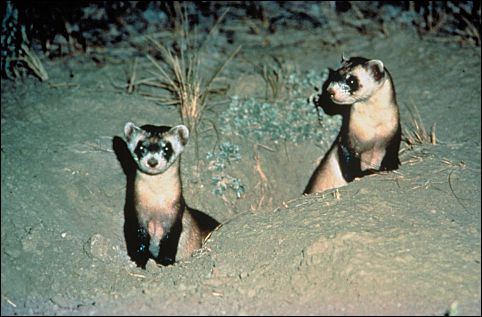

Holding a title is nice, except when it's "North America's most endangered species", long held by the Black-Footed Ferret. Thought to be extinct, a colony was discovered in Wyoming in 1979. Disease nearly wiped out the colony, however, and the surviving 18 individuals were captured to try to save the species. Long-term survival depends on the success of the prairie dogs that comprise 90% of their diet.
Since ranching entered the West, prairie dog numbers have declined
dramatically. Although prairie dog towns help to support over 100 other animal species,
poisoning campaigns and human-caused habitat destruction have left few surviving
colonies. Today there are over 700 ferrets, about half of which live in the wild. In
2001, they were reintroduced into Mexico, near Janos, Chihuahua (about 140 miles
southwest of El Paso), where an estimated 500,000 prairie dogs form the largest
surviving town known. Continued success of captive breeding and release programs, in
addition to protection and promotion of healthy prairie dog colonies, will insure that
the Black-footed Ferret will never again hold the title, "Most
Endangered".

Contributor: Eric A. Trum, Student, University of Texas at El Paso.
Desert Diary is a joint production of the Centennial Museum and KTEP National Public Radio at the University of Texas at El Paso.

Two Black-footed Ferrets (Mustela nigripes). Image by LuRay Parker, courtesy of the U.S. Fish and Wildlife Service.
Biggins, D., J Godbey, L. Hanebury, P Marinari, R. Matchett, and A. Vargas. 1998. Survival of Black-footed Ferrets. Journal of Wildlife Management 62:643-653.
Vargas A, M. Lockhart, P. Marinari, and P. Gober. 1996. The Reintroduction Process: Black-footed Ferrets as a case study. Pp. 829-834, in Proceedings: American Zoo and Aquarium Association Western Regional Conference, May 15-19, 1996, Denver, Colorado.